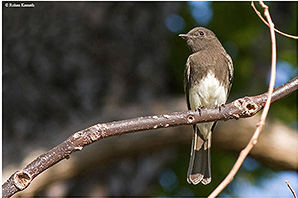 |
Black Phoebe Sayornis nigricans |
|
|
STANFORD LOCATIONS: Uncommon to fairly common resident throughout campus, being somewhat more common fall through spring than during summer. Nests of mud are attached to eaves or the sides of buildings, occasionally built on ledges. The birds often appear more black than brown. |
 |
Location |
Type |
Mating System |
Parental Care |
2ndary Diet |
Strategy |
|
|
|
|
I: 15-17 DAYS ALTRICIAL |
|
|
|
|
|
(3-6) MONOG |
MF |
GLEAN |
| BREEDING: | Near water in woodland, canyon, suburb, farmland with scattered trees, coastal cliff. 2 (occ 3?) broods. |
| DISPLAYS: | In courtship, male performs song flight of fluttering and calling, then slowly descends. |
| NEST: | Adherent also on or under other structures; of mud pellets, plant fibers, hair, lined with hair, rootlets, grass, bark. |
| EGGS: | White, mostly unmarked, some (last laid) with small red spots. 0.8" (19 mm). |
| DIET: | Almost exclusively insects, occ small fish. Regurgitates pellets. |
| CONSERVATION: | Winter resident, but wanders after breeding season. Rare cowbird host. |
| NOTES: | Often feeds just above water surface. Sexes maintain separate winter feeding territories. In winter, also gleans insects from ground |
| ESSAYS: | Bills; Pellets; Passerines and Songbirds. |
| REFERENCES: | Verbeek, 1975a, b. |
| Help | Abbreviations | Species-Alphabetical | Species-Taxonomic | Essays-Alphabetical | |
| Except for Stanford Locations, the material in this species treatment is taken, with permission, from The Birder's Handbook (Paul Ehrlich, David Dobkin, & Darryl Wheye, Simon & Schuster, NY. 1988). | |||||